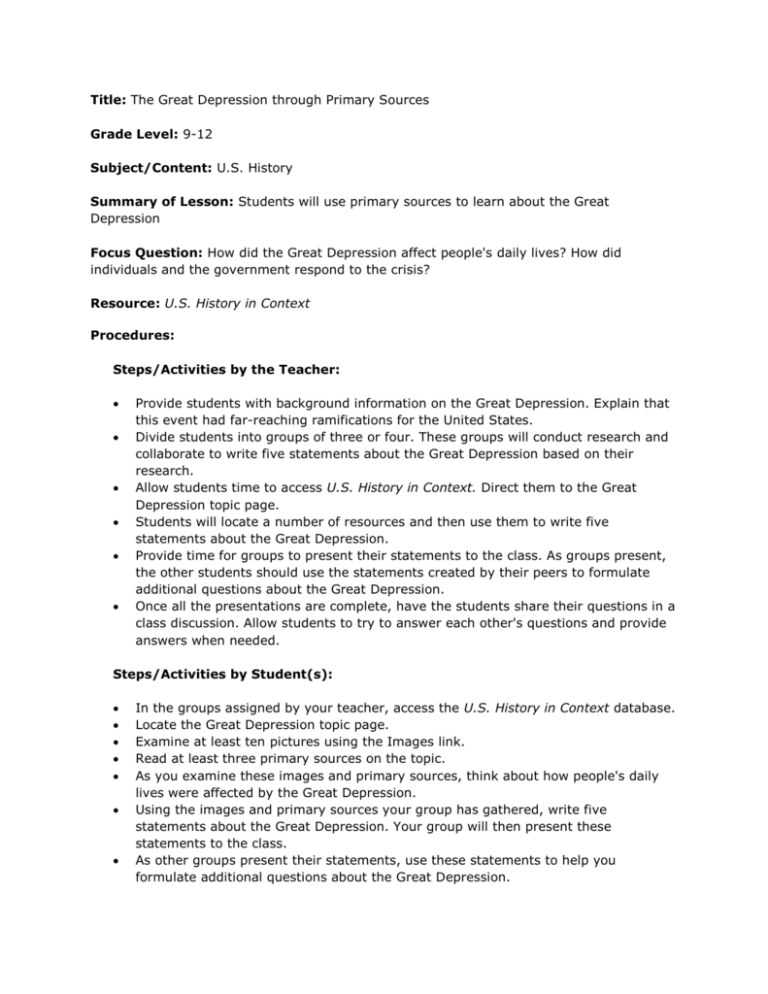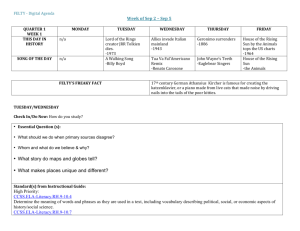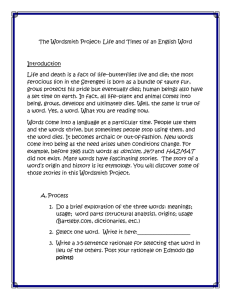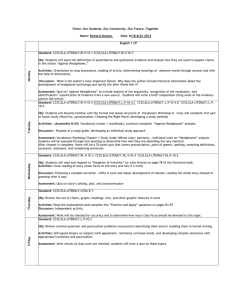The Great Depression using Primary Resources
advertisement

Title: The Great Depression through Primary Sources Grade Level: 9-12 Subject/Content: U.S. History Summary of Lesson: Students will use primary sources to learn about the Great Depression Focus Question: How did the Great Depression affect people's daily lives? How did individuals and the government respond to the crisis? Resource: U.S. History in Context Procedures: Steps/Activities by the Teacher: Provide students with background information on the Great Depression. Explain that this event had far-reaching ramifications for the United States. Divide students into groups of three or four. These groups will conduct research and collaborate to write five statements about the Great Depression based on their research. Allow students time to access U.S. History in Context. Direct them to the Great Depression topic page. Students will locate a number of resources and then use them to write five statements about the Great Depression. Provide time for groups to present their statements to the class. As groups present, the other students should use the statements created by their peers to formulate additional questions about the Great Depression. Once all the presentations are complete, have the students share their questions in a class discussion. Allow students to try to answer each other's questions and provide answers when needed. Steps/Activities by Student(s): In the groups assigned by your teacher, access the U.S. History in Context database. Locate the Great Depression topic page. Examine at least ten pictures using the Images link. Read at least three primary sources on the topic. As you examine these images and primary sources, think about how people's daily lives were affected by the Great Depression. Using the images and primary sources your group has gathered, write five statements about the Great Depression. Your group will then present these statements to the class. As other groups present their statements, use these statements to help you formulate additional questions about the Great Depression. In a class discussion, listen to the questions that other groups have come up with. Use your research to try to answer your peers' questions. Outcome: Students will get a basic overview of life and issues during the Great Depression. Related Activities: English Students may be asked to use their primary sources to compose a diary entry from the perspective of a person living during the Great Depression. Learning Expectation: Students will use their research skills to find articles about the Great Depression. They will then analyze these sources to produce statements about how the Great Depression affected people and the nation and formulate additional questions about the topic. Standards Alignment Common Core State Standards CCSS.ELA-Literacy.CCRA.R.7: Integrate and evaluate content presented in diverse media and formats, including visually and quantitatively, as well as in words (Anchor Standard). CCSS.ELA-Literacy.CCRA.R.10: Read and comprehend complex literary and informational texts independently and proficiently (Anchor Standard). CCSS.ELA-Literacy.CCRA.W.10: Write routinely over extended time frames (time for research, reflection, and revision) and shorter time frames (a single sitting or a day or two) for a range of tasks, purposes, and audiences (Anchor Standard). CCSS.ELA-Literacy.RI.9-10.7: Analyze various accounts of a subject told in different mediums (e.g., a person’s life story in both print and multimedia), determining which details are emphasized in each account (9-10). CCSS.ELA-Literacy.RI.9-10.9: Analyze seminal U.S. documents of historical and literary significance (e.g., Washington’s Farewell Address, the Gettysburg Address, Roosevelt’s Four Freedoms speech, King’s “Letter from Birmingham Jail”), including how they address related themes and concepts (9-10). CCSS.ELA-Literacy.RI.9-10.10: By the end of grade 9, read and comprehend literacy nonfiction in the grades 9-10 text complexity band proficiently, with scaffolding as needed at the high end of the range (9). By the end of grade 10, read and comprehend literary nonfiction at the high end of the grades 9-10 text complexity band independently and proficiently (10). CCSS.ELA-Literacy.W.9-10.10: Write routinely over extended time frames (time for research, reflection, and revision) and shorter time frames (a single sitting or a day or two) for a range of tasks, purposes, and audiences (9-10). CCSS.ELA-Literacy.RH.9-10.9: Compare and contrast treatments of the same topic in several primary and secondary sources (9-10). CCSS.ELA-Literacy.RH.9-10.10: By the end of grade 10, read and comprehend history/social studies texts in the grades 9–10 text complexity band independently and proficiently (9-10). CCSS.ELA-Literacy.RH.11-12.7: Integrate and evaluate multiple sources of information presented in diverse formats and media (e.g., visually, quantitatively, as well as in words) in order to address a question or solve a problem (11-12). CCSS.ELA-Literacy.RH.11-12.9: Integrate information from diverse sources, both primary and secondary, into a coherent understanding of an idea or event, noting discrepancies among sources (11-12). CCSS.ELA-Literacy.RH.11-12.10: By the end of grade 12, read and comprehend history/social studies texts in the grades 11–CCR text complexity band independently and proficiently (11-12). Standard Source: Common Core State Standards Initiative (2010)







